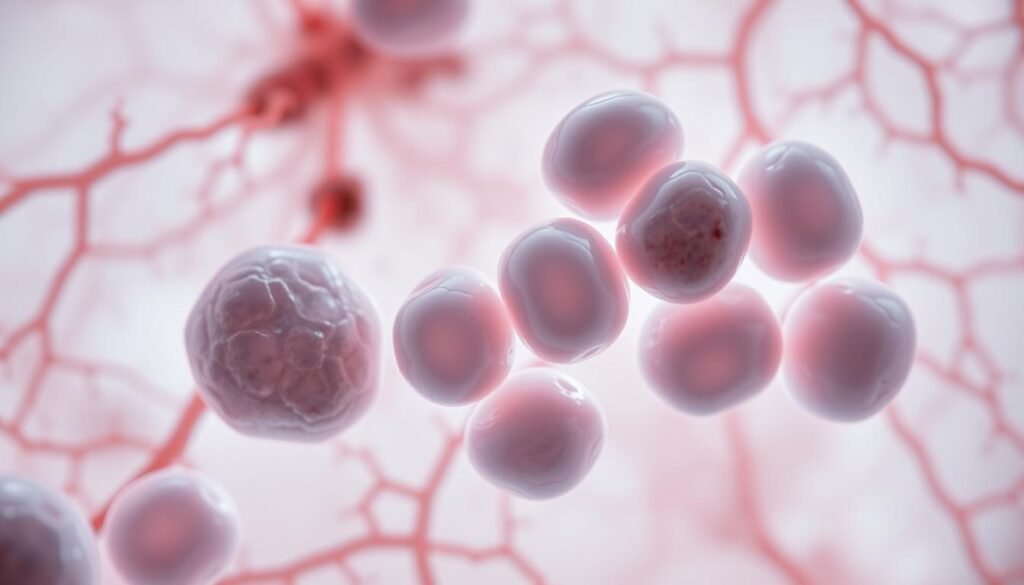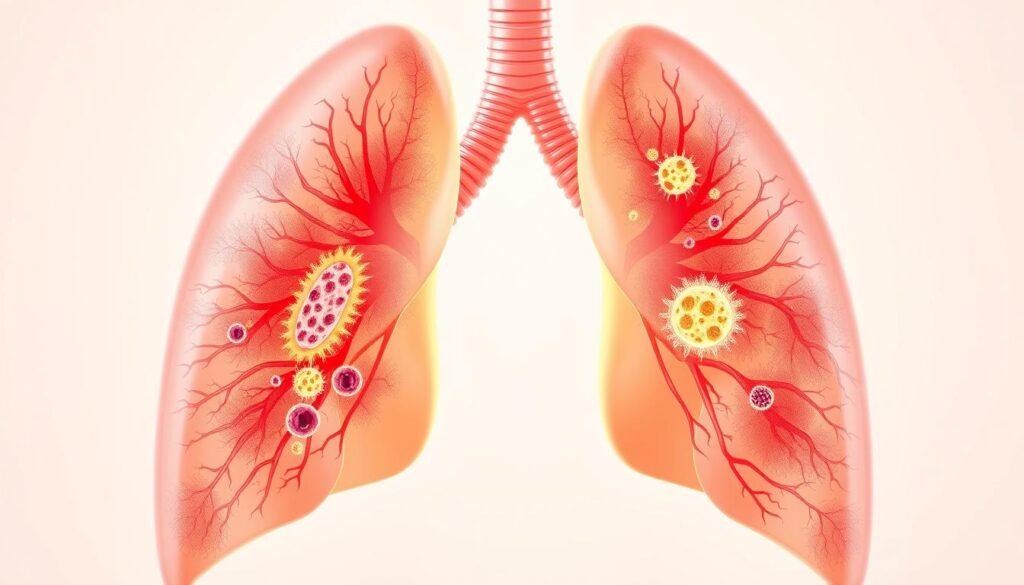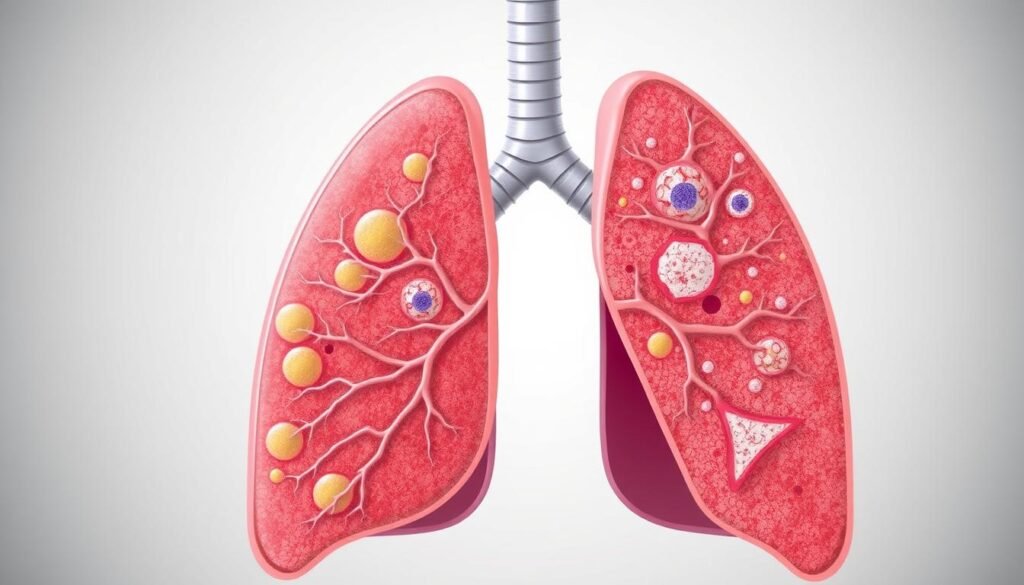Did you know small cell lung cancer (SCLC) is only about 15% of all lung cancer cases? Yet, it’s known for being very aggressive. On the other hand, non-small cell lung cancer (NSCLC) makes up nearly 90% of cases. Knowing the difference between these two is very important for diagnosis, treatment, and improving patient outcomes.
Knowing the difference helps patients and doctors come up with better treatment plans. This can lead to a greater chance of surviving and managing the disease well.
This article will explore how SCLC and NSCLC are different. We’ll look at their aggressive nature and treatment methods. These insights are useful for anyone touched by this illness.
Key Takeaways
- SCLC accounts for about 15% of lung cancers, while NSCLC makes up nearly 90%.
- SCLC is more aggressive and often spreads quickly compared to NSCLC.
- Smoking is linked to over 98% of SCLC cases, while NSCLC has various types.
- Early detection of NSCLC significantly enhances survival rates.
- Treatment approaches for SCLC and NSCLC differ markedly.
Understanding Lung Cancer
Lung cancer includes many types of cancers starting in lung tissues. These cancers mainly affect the airways and can be severe. There are two primary kinds: small cell lung cancer (SCLC) and non-small cell lung cancer (NSCLC). About 10% to 15% of lung cancers are SCLC, and NSCLC makes up about 80% to 85%.
Non-small cell lung cancer has different forms. The most common is adenocarcinoma. There’s also squamous cell carcinoma, linked to smoking, and large cell carcinoma, which grows fast and is hard to treat. Knowing these differences is key to finding the right treatment.
Many factors can lead to lung cancer. Smoking is behind about 90% of cases and is closely linked to the aggressive SCLC. Things like pollution and genes also play roles. Catching it early through screening can help beat lung cancer.
Watch for lung cancer signs like ongoing cough, trouble breathing, and losing weight without trying. If you’re at risk, talk to your doctor about screening for SCLC and NSCLC. For more details on these cancers, check out this informative resource.
What is Small Cell Lung Cancer (SCLC)?
Small cell lung cancer (SCLC) is a fast-growing form of lung cancer. It usually starts in the bronchi. About 10% to 15% of lung cancers are SCLC.
This cancer spreads quickly to places like lymph nodes, bones, and the brain. Finding it early is hard but very important.
It’s vital to know how small cell lung cancer acts for early detection and treatment. Symptoms appear suddenly and get worse fast. Quick medical help is needed.
While treatments like chemotherapy can initially work well, the cancer often comes back. This makes staying informed about SCLC key for handling it effectively.
For more detailed insights, consider reading about the implications of early detection and treatment options.

Characteristics of Small Cell Lung Cancer
Small Cell Lung Cancer (SCLC) is known for its small, round cells. These cells grow faster than those in non-small cell lung cancer (NSCLC). This fast growth makes it very aggressive and often spreads widely at diagnosis. It’s important to know about these characteristics to understand treatment and the future of the disease.
SCLC is split into two types: small cell carcinoma and combined small cell carcinoma. Combined small cell carcinoma has both small and non-small cell parts. Studies show 5–28% of SCLC cases are this mixed type. This helps doctors decide on the best treatment and predict outcomes for patients.
SCLC tumors are different when looked at closely. They show a lot of cell division and tissue death. This is unlike NSCLC, which is more stable and less aggressive. SCLC generally has a worse outlook. The American Cancer Society says the 5-year survival rate averages at only 7%. This underlines the critical need for better treatments.
- Small, round cells distinguish SCLC from other lung cancer types.
- Highly aggressive behavior with rapid growth and metastasis.
- Commonly classified into small cell carcinoma and combined small cell carcinoma.
- Microscopically identifiable by high mitotic rates and necrosis.
- Lower survival rates compared to NSCLC.
Doctors must know these SCLC features to plan treatments and predict patient futures. The aggressive behavior of SCLC poses big health risks. Knowing about it and catching it early is key to helping patients.
What is Non-Small Cell Lung Cancer (NSCLC)?
Non-small cell lung cancer (NSCLC) is the most common type of lung cancer. It makes up about 80% of all lung cancer cases. Unlike small cell lung cancer, NSCLC grows slower. This means it is often found later on.
There are different kinds of NSCLC, such as adenocarcinoma, squamous cell carcinoma, and large cell carcinoma. Each type has its own features and locations in the lungs. Adenocarcinoma usually appears in the outer parts of the lungs. Squamous cell carcinoma is often closer to the middle, near the bronchial tubes. Large cell carcinoma can develop anywhere in the lungs and tends to grow quickly.
There are also rare types like Pancoast tumors and carcinoid tumors. Pancoast tumors start in the upper part of the lung. Carcinoid tumors grow slowly and are typically treated with surgery. These differences show how complex NSCLC is.
Finding NSCLC early leads to a better chance of treating it successfully. Surgery can often help in early stages. In the later stages, even though a complete cure might not be possible, there are treatments. These can help patients live longer, better lives.

Types of Non-Small Cell Lung Cancer
Non-small cell lung cancer (NSCLC) includes various types with different traits and treatment needs. These differences are crucial for diagnosis and deciding on a treatment plan. The main subtypes are adenocarcinoma, squamous cell carcinoma, and large cell carcinoma.
Adenocarcinoma
Adenocarcinoma is the most common lung cancer type, making up about 40% of cases. It starts in the cells that make mucus in the lungs. Often found in non-smokers, it usually grows in the lungs’ outer parts. Finding it early and using specific treatments can really help patients.
Squamous Cell Carcinoma
Squamous cell carcinoma accounts for around 20% of lung cancers, often linked to smoking. It usually starts in the central lungs, near the bronchi. Early detection can lead to better survival chances, making screenings important.
Large Cell Carcinoma
Large cell carcinoma makes up 10 to 15% of NSCLC cases. It grows fast and can be found anywhere in the lung. Because it’s so aggressive, treatment often involves surgery, chemo, and radiation. Each patient needs a plan that fits their unique situation.

Differences between small and non-small cell lung cancer
Understanding the differences between small and non-small cell lung cancer is key. Small cell lung cancer (SCLC) makes up about 15 to 20% of lung cancer cases. In contrast, non-small cell lung cancer (NSCLC) accounts for 80 to 85% of cases. This shows that NSCLC is way more common.
SCLC grows fast and often spreads early, making it hard to treat. On the other side, NSCLC grows slower. Catching it early can sometimes lead to more effective treatments.
SCLC typically starts in the bronchi and is mainly oat-cell type. NSCLC has three main types: adenocarcinoma, squamous cell carcinoma, and large cell carcinoma. Adenocarcinoma, which is very common in the U.S., begins in the mucus-producing glands of the airway. Squamous cell carcinoma starts in the cells lining the bronchi. Large cell carcinoma, with larger cancer cells, appears in different lung areas.
The way we treat these cancers reflects their differences. SCLC usually requires chemotherapy because it grows quickly. But NSCLC might be treated with surgery, targeted therapy, and immunotherapy, based on the stage of cancer.
For more specific information, visit understanding lung cancer differences.
| Feature | Small Cell Lung Cancer (SCLC) | Non-Small Cell Lung Cancer (NSCLC) |
|---|---|---|
| Prevalence | 15-20% | 80-85% |
| Growth Rate | Rapid | Slower |
| Typical Treatment | Chemotherapy | Surgery, Chemotherapy, Targeted Therapy |
| Prognosis | Generally poorer | Generally better |
Knowing the differences between small cell and non-small cell lung cancer is crucial. It helps with early detection and choosing the best treatment. Understanding these differences is important for talking with doctors and planning the best care.
Small Cell Lung Cancer Symptoms
Knowing the signs of small cell lung cancer is key to early diagnosis and treatment. Symptoms differ based on the stage of the cancer. It’s important to tell apart early signs from those showing the cancer has advanced. This knowledge can lead to quicker medical help, improving chances of recovery.
Common Symptoms
Early indicators of small cell lung cancer usually are:
- Persistent cough – A lasting cough can be alarming.
- Chest discomfort – People may feel pain or a squeezing sensation in their chest.
- Weight loss – Losing weight without trying is often a clue that something’s wrong.
- Shortness of breath – Having a hard time breathing is common as the cancer grows.
These signs may seem like other health issues. That’s why it’s crucial to talk to a doctor if they don’t go away.
Advanced Symptoms
When small cell lung cancer gets worse, symptoms can change and include:
- Neurological changes – Signs like confusion, seizures, or headaches might mean the cancer has spread to the brain.
- Bone pain – If the cancer moves to the bones, it can hurt a lot.
- Fatigue and weakness – Feeling extremely tired, even after resting, could point to advanced cancer.
- Horner’s syndrome – This condition affects the eye and face, leading to drooping eyelids and smaller pupils.
Knowing about these severe symptoms is crucial. It can push people to get checked out and consider their treatment choices sooner. To learn more about lung cancer symptoms, check out this resource.
| Type of Symptoms | Description |
|---|---|
| Common Symptoms | Persistent cough, chest discomfort, weight loss, shortness of breath |
| Advanced Symptoms | Neurological changes, bone pain, fatigue, Horner’s syndrome |
Non-Small Cell Lung Cancer Staging
Understanding non-small cell lung cancer (NSCLC) staging is key. It tells us how severe the cancer is and what treatments can help. Unlike its counterpart, small cell lung cancer, NSCLC uses a detailed system for classification.
The TNM staging system is the standard for NSCLC. It looks at tumor size (T), whether lymph nodes are involved (N), and if the cancer has spread (M). Stages go from 0 to IV. Lower stages mean the cancer hasn’t spread much, which is good news.
Here’s a breakdown of the stages:
| Stage | Description | Tumor Size | Spread | Treatment Options |
|---|---|---|---|---|
| 0 | Localized without spreading | Any size | None | Monitoring |
| I | Small tumors in one lung | IA (≤3 cm), IB (>3 cm but ≤4 cm) | None | Lobectomy recommended |
| II | Tumor remains in lung with larger size or lymph node involvement | IIB (>4 cm but ≤5 cm) | Some lymph node involvement | Possible surgery, chemotherapy |
| III | Spread within the chest but not to distant sites | Variable | Involvement of chest lymph nodes | Chemotherapy, radiation |
| IV | Metastatic, cancer has spread to distant organs | Any size | Spread to bones, brain, etc. | Targeted therapy, palliative care |
In Stage 1 NSCLC, minimally invasive surgery is often possible. About 8 in 10 patients could see benefits from this approach. When the cancer advances to stages III and IV, the focus shifts. Then, options like chemotherapy and radiation are used to target where the cancer has spread.
Treatment Options for Small Cell Lung Cancer
Small cell lung cancer (SCLC) needs fast and aggressive treatment. This is because the disease gets worse quickly. Doctors use chemotherapy and radiation therapy to fight it. These treatments aim to stop the cancer and help patients live longer.
Chemotherapy
Chemotherapy is key in fighting small cell lung cancer. It uses strong drugs to destroy cancer cells. Patients often get several drugs together to make the treatment stronger. Without treatment, patients with SCLC usually survive only 2 to 4 months after being diagnosed. But with chemotherapy, their survival time can increase significantly. This is especially true for those with a less advanced disease.
Radiation Therapy
Radiation therapy is also used, especially for early-stage disease. It’s given with chemotherapy to help patients live longer. Thoracic radiation therapy (TRT) can raise survival odds by about 5% over chemotherapy alone. There’s also prophylactic cranial radiation. This helps prevent the cancer from spreading to the brain, which also helps patients survive longer.
| Treatment | Type | Median Survival Without Treatment | Median Survival With Treatment |
|---|---|---|---|
| Chemotherapy | Systemic | 2 to 4 months | 16 to 24 months (LD) |
| Radiation Therapy | Localized | 2 to 4 months | 6 to 12 months (ED) with TRT |
Treatment Options for Non-Small Cell Lung Cancer
Non-small cell lung cancer (NSCLC), representing more than 80 percent of lung cancer cases, offers various treatment options. These options depend on the disease’s type and stage. Surgical interventions are a primary treatment for early-stage NSCLC, like Stage 0. At this stage, surgery alone can be enough.
This early treatment allows patients to avoid chemotherapy or radiation. As the cancer grows, treatment for non-small cell lung cancer gets more complex. In Stage I, surgeries like lobectomy and segmentectomy can cure the disease. With Stage II, adding chemotherapy before surgery can help a lot.
In Stage IIIA, patients might need chemotherapy, radiation, and immunotherapy along with surgery. Stage IIIB usually combines chemotherapy with radiation.
For stages IVA and IVB, a comprehensive strategy is needed. This may include surgery, chemotherapy, targeted therapy, and immunotherapy. Targeted therapies focus on specific gene mutations. Immunotherapy uses PD-L1 protein levels to guide treatment.
These treatment options aim to control the disease and extend survival. Tests like chest X-rays and biopsies are key in choosing the right treatment. Early detection leads to better outcomes, highlighting the need for timely detection.
But treatment is more than just fighting cancer. Support services, like pain management and nutritional help, improve life quality. Quitting smoking after diagnosis also helps a lot.
Understanding your treatment options for non-small cell lung cancer is vital for good management. Each patient’s path is different, needing a tailored approach for the best health outcome.
Conclusion
Knowing the difference between small cell lung cancer (SCLC) and non-small cell lung cancer (NSCLC) is key. SCLC makes up about 20% of lung cancer cases and often has a worse outcome. Meanwhile, NSCLC represents the other 80% and can have varying chances of survival, depending on the subtype.
Getting the right treatment early can be harder for small cell lung cancer. But for non-small cell lung cancer, there’s hope. New therapies and drugs are helping people live longer. Researchers are also finding out what makes these cancers tick. This could lead to better treatment options.
Lung cancer is the top cause of cancer deaths worldwide. This makes finding it early and choosing the right treatment very important. With ongoing research and better healthcare, we can improve survival rates for both SCLC and NSCLC. This research could change lives for the better.